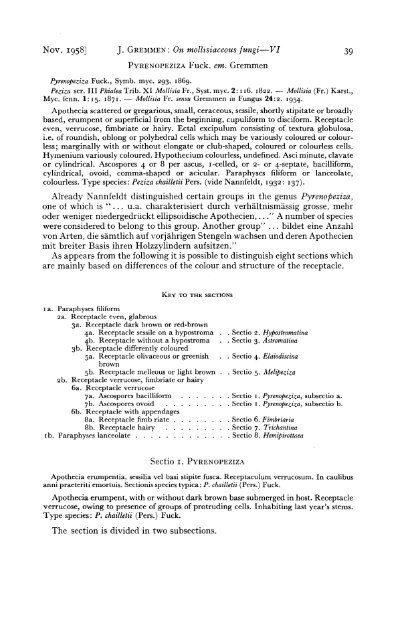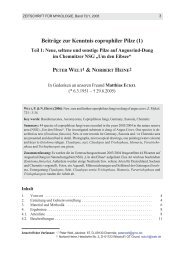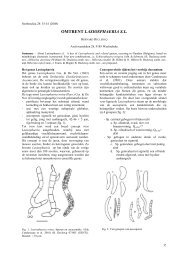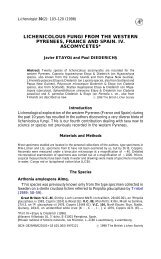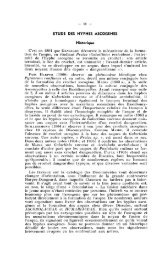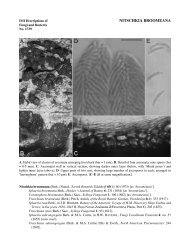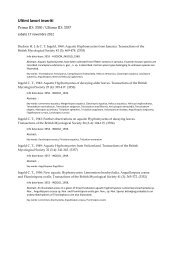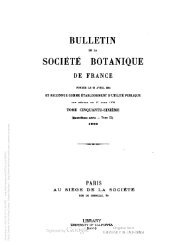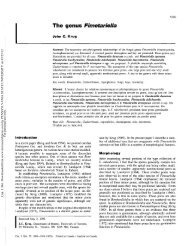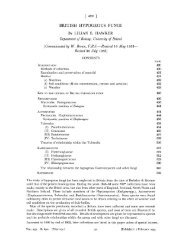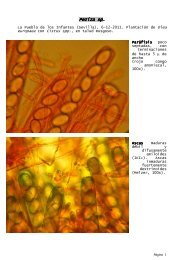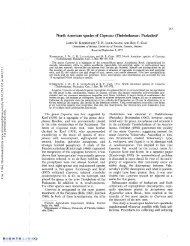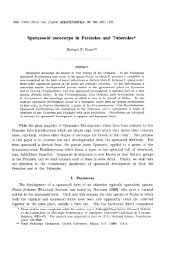The genus Pyrenopeziza Fuck. - ASCOfrance
The genus Pyrenopeziza Fuck. - ASCOfrance
The genus Pyrenopeziza Fuck. - ASCOfrance
You also want an ePaper? Increase the reach of your titles
YUMPU automatically turns print PDFs into web optimized ePapers that Google loves.
Nov. 1958J J. GREMMEN: On mollisiaceous fungi-VI<br />
PYRENOPEZIZA <strong>Fuck</strong>. em. Gremmen<br />
<strong>Pyrenopeziza</strong> <strong>Fuck</strong>., Symb. myc. 293. 1869.<br />
Peziza ser. III Phialea Trib. XI Mollisia Fr., Syst. myc. 2: 116. 1822. - Mollisia (Fr.) Karst.,<br />
Myc. fenn. 1: IS. 1871. - Mollisia Fr. sensu Gremmen in Fungus 24:2. 1954.<br />
Apothecia scattered or gregarious, small, ceraceous, sessile, shortly stipitate or broadly<br />
based, erumpent or superficial from the beginning, cupuliform to disciform. Receptacle<br />
even, verrucose, fimbriate or hairy. Ectal excipulum consisting of textura globulosa,<br />
i.e. of roundish, oblong or polyhedral cells which may be variously coloured or colourless;<br />
marginally with or without elongate or club-shaped, coloured or colourless cells.<br />
Hymenium variously coloured. Hypothecium colourless, undefined. Asci minute, clavate<br />
or cylindrical. Ascospores 4 or 8 per ascus, I-celled, or 2- or 4-septate, bacilliform,<br />
cylindrical, ovoid, comma-shaped or acicular. Paraphyses filiform or lanceolate,<br />
colourless. Type species: Peziza chailletii Pers. (vide Nannfeldt, 1932: 137).<br />
Already Nannfeldt distinguished certain groups in the <strong>genus</strong> <strong>Pyrenopeziza</strong>,<br />
one of which is " ... u.a. charakterisiert durch verhaltnismassig grosse, mehr<br />
oder weniger niedergedriickt ellipsoidische Apothecien, ..." A number of species<br />
were considered to belong to this group. Another group" ... bildet eine Anzahl<br />
von Arten, die samtlich auf vorjahrigen Stengeln wachsen und deren Apothecien<br />
mit breiter Basis ihren Holzzylindern aufsitzen."<br />
As appears from the following it is possible to distinguish eight sections which<br />
are mainly based on differences of the colour and structure of the receptacle.<br />
KEY TO THE SECTIONS<br />
I a. Paraphyses filiform<br />
2a. Receptacle even, glabrous<br />
3a. Receptacle dark brown or red-brown<br />
4a. Receptacle sessile on a hypostroma<br />
4b. Receptacle without a hypostroma<br />
3b. Receptacle differently coloured<br />
sa. Receptacle olivaceous or greenish<br />
brown<br />
5b. Receptacle melleous or light brown<br />
2b. Receptacle verrucose, fimbriate or hairy<br />
6a. Receptacle verrucose<br />
7a. Ascospores bacilliform<br />
7b. Ascospores ovoid<br />
6b. Receptacle with appendages<br />
8a. Receptacle fimb riate<br />
8b. Receptacle hairy<br />
Ib. Paraphyses lanceolate . . . . . . .<br />
Sectio 1. PYRENOPEZIZA<br />
· Sectio 2. Hypostromatina<br />
· Sectio 3. Astromatina<br />
· Sectio 4. Elaiodiscina<br />
· Sectio 5. Melipeziza<br />
· Sectio I. <strong>Pyrenopeziza</strong>, subsectio a.<br />
· Sectio I. <strong>Pyrenopeziza</strong>, subsectio b.<br />
· Sectio 6. Fimbriaria<br />
· Sectio 7. Trichantina<br />
· Sectio 8. Hemipirottaea<br />
Apothecia erumpentia, sessilia vel basi stipite fusca. Receptaculum verrucosum. In caulibus<br />
anni praeteriti emortuis. Sectionis species typica: P. chailletii (Pers.) <strong>Fuck</strong>.<br />
Apothecia erumpent, with or without dark brown base submerged in host. Receptacle<br />
verrucose, owing to presence of groups of protruding cells. Inhabiting last year's sterns.<br />
Type species: P. chailletii (Pers.) <strong>Fuck</strong>.<br />
<strong>The</strong> section is divided in two subsections.<br />
39


